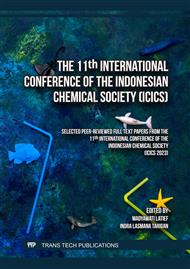[1]
Defri Yona, Mahatma Farrel Zahran, M. Arif Zainul Fuad, Yuniar Ponco Prananto, and Ledhyane Ika Harlyan, Mikroplastik di Perairan. Malang: UB Press, 2021.
Google Scholar
[2]
R. Ahmed, A. K. Hamid, S. A. Krebsbach, J. He, and D. Wang, "Critical review of microplastics removal from the environment," Chemosphere, vol. 293, p.133557, Apr. 2022.
DOI: 10.1016/j.chemosphere.2022.133557
Google Scholar
[3]
Y. Hu, L. Zhou, J. Zhu, and J. Gao, "Efficient removal of polyamide particles from wastewater by electrocoagulation," J. Water Process Eng., vol. 51, p.103417, Feb. 2023.
DOI: 10.1016/j.jwpe.2022.103417
Google Scholar
[4]
Z. Yuan, R. Nag, and E. Cummins, "Human health concerns regarding microplastics in the aquatic environment - From marine to food systems," Sci. Total Environ., vol. 823, p.153730, Jun. 2022.
DOI: 10.1016/j.scitotenv.2022.153730
Google Scholar
[5]
Masduqi, Ali and Abdu F.Assomadi, "Operasi & Proses Pengolahan Air Edisi Kedua," 2nd ed., Surabaya: ITS Press, 2016, p. vi + 359 hlm.
Google Scholar
[6]
L. Li, G. Xu, H. Yu, and J. Xing, "Dynamic membrane for micro-particle removal in wastewater treatment: Performance and influencing factors," Sci. Total Environ., vol. 627, p.332–340, Jun. 2018.
DOI: 10.1016/j.scitotenv.2018.01.239
Google Scholar
[7]
A. F. Herbort, M. T. Sturm, S. Fiedler, G. Abkai, and K. Schuhen, "Alkoxy-silyl Induced Agglomeration: A New Approach for the Sustainable Removal of Microplastic from Aquatic Systems," J. Polym. Environ., vol. 26, no. 11, p.4258–4270, Nov. 2018.
DOI: 10.1007/s10924-018-1287-3
Google Scholar
[8]
A. Paço et al., "Biodegradation of polyethylene microplastics by the marine fungus Zalerion maritimum," Sci. Total Environ., vol. 586, p.10–15, May 2017.
DOI: 10.1016/j.scitotenv.2017.02.017
Google Scholar
[9]
M. Padervand, E. Lichtfouse, D. Robert, and C. Wang, "Removal of microplastics from the environment. A review," Environ. Chem. Lett., vol. 18, no. 3, p.807–828, May 2020.
DOI: 10.1007/s10311-020-00983-1
Google Scholar
[10]
M. Shen et al., "Efficient removal of microplastics from wastewater by an electrocoagulation process," Chem. Eng. J., vol. 428, p.131161, Jan. 2022.
DOI: 10.1016/j.cej.2021.131161
Google Scholar
[11]
C. Akarsu, H. Kumbur, and A. E. Kideys, "Removal of microplastics from wastewater through electrocoagulation-electroflotation and membrane filtration processes," Water Sci. Technol., vol. 84, no. 7, p.1648–1662, Oct. 2021.
DOI: 10.2166/wst.2021.356
Google Scholar
[12]
D. Elkhatib, V. Oyanedel-Craver, and E. Carissimi, "Electrocoagulation applied for the removal of microplastics from wastewater treatment facilities," Sep. Purif. Technol., vol. 276, p.118877, Dec. 2021.
DOI: 10.1016/j.seppur.2021.118877
Google Scholar
[13]
M. Kobya, A. Akyol, E. Demirbas, and M. S. Oncel, "Removal of arsenic from drinking water by batch and continuous electrocoagulation processes using hybrid Al-Fe plate electrodes," Environ. Prog. Sustain. Energy, vol. 33, no. 1, p.131–140, Apr. 2014.
DOI: 10.1002/ep.11765
Google Scholar
[14]
G. Mouedhen, M. Feki, M. D. P. Wery, and H. F. Ayedi, "Behavior of aluminum electrodes in electrocoagulation process," J. Hazard. Mater., vol. 150, no. 1, p.124–135, Jan. 2008.
DOI: 10.1016/j.jhazmat.2007.04.090
Google Scholar
[15]
W. Perren, A. Wojtasik, and Q. Cai, "Removal of Microbeads from Wastewater Using Electrocoagulation," ACS Omega, vol. 3, no. 3, p.3357–3364, Mar. 2018.
DOI: 10.1021/acsomega.7b02037
Google Scholar
[16]
Avio, C. G., Gorbi, S., Milan, M., Benedetti, M., Fattorini, D., d'Errico, G., … Regoli, F. (2015). Pollutants bioavailability and toxicological risk from microplastics to marine mussels. Environmental Pollution, 198, 211–222.
DOI: 10.1016/j.envpol.2014.12.021
Google Scholar
[17]
Wesley R. Harris, Guy Berthon, J. P, "Speciation of Aluminium in Biological Systems," J. Toxicol. Environ. Health, vol. 48, no. 6, p.543–568, Aug. 1996.
DOI: 10.1080/009841096161069
Google Scholar
[18]
A. Wołowicz and K. Staszak, "Study of surface properties of aqueous solutions of sodium dodecyl sulfate in the presence of hydrochloric acid and heavy metal ions," J. Mol. Liq., vol. 299, p.112170, Feb. 2020.
DOI: 10.1016/j.molliq.2019.112170
Google Scholar
[19]
A. Allahbakhsh and S. Mazinani, "Influences of sodium dodecyl sulfate on vulcanization kinetics and mechanical performance of EPDM/graphene oxide nanocomposites," RSC Adv., vol. 5, no. 58, p.46694–46704, 2015.
DOI: 10.1039/C5RA00394F
Google Scholar
[20]
Ramadani, A. I., Fardiyah, Q., & Rumhayati, B, "The Study of Removal of Polyvinyl Chloride (PVC) Particles from Wastewater through Electrocoagulation". Indonesian Journal of Chemistry, 24(5), 1498–1513. 2024.
DOI: 10.22146/ijc.95589
Google Scholar
[21]
Jafari, E., Malayeri, M.R. Bruckner, H., & Krebs, P, "Impact of Operating Parameters of Electrocoagulation-flotation on the removal of turbidit from synthetic wastewater using aluminium electrodes". Minerals Engineering, 193, 108007.2023.
DOI: 10.1016/j.mineng.2023.108007
Google Scholar


